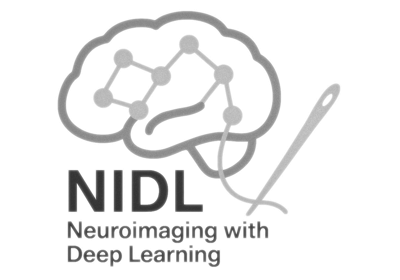Deep learning for NeuroImaging in Python.
Note
This page is a reference documentation. It only explains the class signature, and not how to use it. Please refer to the gallery for the big picture.
- class nidl.estimators.linear.LogisticRegression(model: Module, num_classes: int, lr: float, weight_decay: float, random_state: int | None = None, **kwargs)[source]¶
Bases:
ClassifierMixin,BaseEstimatorLogisticRegression implementation.
This class can also be used in self supervised settings. After we have trained our encoder via self supervised learning, we can deploy it on downstream tasks and see how well it performs with little data. A common setup, which also verifies whether the model has learned generalized representations, is to perform Logistic Regression on the features. In other words, we learn a MLP that maps the representations to a class prediction. If very little data is available, it might be beneficial to dynamically encode the images during training so that we can also apply data augmentations. To freeze the input encoder, consider using
LogisticRegression.freeze_encoder(). It assumes the MLP layer is named fc.- Parameters:
model : nn.Module
the encoder f(.) architecture.
num_classes : int
the number of class to predict.
lr : float
the learning rate.
temperature : float
the SimCLR loss temperature parameter.
weight_decay : float
the Adam optimizer weight decay parameter.
max_epochs : int, default=None
optionaly, use a MultiStepLR scheduler.
random_state : int, default=None
setting a seed for reproducibility.
kwargs : dict
Trainer parameters.
Notes
A batch of data must contains two elements: a tensor with images, and a tensor with the variable to predict.
Examples
>>> model = nn.Sequential(OrderedDict([ >>> ("encoder", encoder), >>> ("fc", nn.Linear(latent_size, num_classes)) >>> ]))
Attributes
model
a
Modulecontaining the prediction model.validation_step_outputs
a dictionnary with the validation predictions and associated labels in the ‘pred’, and ‘label’ keys, respectivelly.
- configure_optimizers()[source]¶
Declare a
AdamWoptimizer and, optionnaly (max_epochsis defined), aMultiStepLRlearning-rate scheduler.
- cross_entropy_loss(batch: tuple[Tensor, Sequence[Tensor]], mode: str)[source]¶
Compute and log the InfoNCE loss using
cross_entropy().
- predict_step(batch: Tensor, batch_idx: int, dataloader_idx: int | None = 0)[source]¶
Step function called during
predict(). By default, it callsforward(). Override to add any processing logic.The
predict_step()is used to scale inference on multi-devices.To prevent an OOM error, it is possible to use
BasePredictionWritercallback to write the predictions to disk or database after each batch or on epoch end.The
BasePredictionWritershould be used while using a spawn based accelerator. This happens for training strategystrategy="ddp_spawn"or training on 8 TPU cores withaccelerator="tpu", devices=8as predictions won’t be returned.- Parameters:
batch : iterable, normally a
DataLoaderthe current data.
batch_idx : int
the index of this batch.
dataloader_idx : int, default=0
the index of the dataloader that produced this batch (only if multiple dataloaders are used).
- Returns:
out : Any
the predicted output.
- training_step(batch: tuple[Tensor, Tensor], batch_idx: int, dataloader_idx: int | None = 0)[source]¶
Here you compute and return the training loss and some additional metrics for e.g. the progress bar or logger.
- Parameters:
batch : iterable, normally a
DataLoaderthe current data.
batch_idx : int
the index of this batch.
dataloader_idx : int, default=0
the index of the dataloader that produced this batch (only if multiple dataloaders are used).
- Returns:
loss : STEP_OUTPUT
the computed loss:
Tensor- the loss tensor.dict- a dictionary which can include any keys, but must include the key'loss'in the case of automatic optimization.None- in automatic optimization, this will skip to the next batch (but is not supported for multi-GPU, TPU, or DeepSpeed). For manual optimization, this has no special meaning, as returning the loss is not required.
To use multiple optimizers, you can switch to ‘manual optimization’
and control their stepping:
Notes
When
accumulate_grad_batches> 1, the loss returned here will be automatically normalized byaccumulate_grad_batchesinternally.Examples
>>> def __init__(self): >>> super().__init__() >>> self.automatic_optimization = False >>> >>> >>> # Multiple optimizers (e.g.: GANs) >>> def training_step(self, batch, batch_idx): >>> opt1, opt2 = self.optimizers() >>> >>> # do training_step with encoder >>> ... >>> opt1.step() >>> # do training_step with decoder >>> ... >>> opt2.step()
- validation_step(batch: tuple[Tensor, Tensor], batch_idx: int, dataloader_idx: int | None = 0)[source]¶
Operates on a single batch of data from the validation set. In this step you’d might generate examples or calculate anything of interest like accuracy.
- Parameters:
batch : iterable, normally a
DataLoaderthe current data.
batch_idx : int
the index of this batch.
dataloader_idx : int, default=0
the index of the dataloader that produced this batch (only if multiple dataloaders are used).
- Returns:
loss : STEP_OUTPUT
the computed loss:
Tensor- the loss tensor.dict- a dictionary. can include any keys, but must include the key'loss'.None- skip to the next batch.
Notes
When the
validation_step()is called, the model has been put in eval mode and PyTorch gradients have been disabled. At the end of validation, the model goes back to training mode and gradients are enabled.
Examples¶
Follow us

